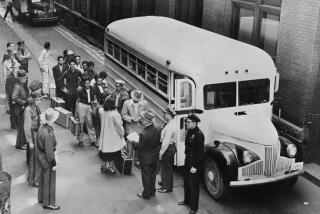Museum Boosters Seek to Capture San Dieguito’s Essence for History
- Share via
Nowadays, when Frank Knechtel gazes across the expansive Carmel Valley, he can only dream of what once was--field after field of lima beans, one of North County’s staple crops for much of this century.
In the Depression years, when Knechtel was a boy racing about his father’s farm, more than a hundred lima bean growers thrived between Del Mar and Carlsbad. Twenty years later, his own lima bean crop sprawled across 500 fertile acres.
Today, Knechtel (pronounced Necktel) is one of the last lima bean growers left in San Diego County. And, after this year, even he is calling it quits.
But the 72-year-old is leaving behind a little memento of those years when farmers like himself worked their fields under the scorching Southern California sun.
Actually, it’s a rather large memento--a 40-by-14-foot lima bean harvester that has been used to help reap North County bean crops for much of the past half century.
One of Many Donations
The harvester is one of scores of objects d’history that have been donated for a proposed San Dieguito Heritage Museum, which a group of residents wants to see built in Encinitas.
The mementos include old photographs, horse-drawn buggies, antiques and Indian artifacts, many of which hark back more than 100 years to an era when North County was being settled by the first waves of ambitious European and Japanese immigrants.
But none, perhaps, are as large--or as cherished--as Frank Knechtel’s harvester.
“They asked me about the harvester, and I said I’d donate it when they have a place to put it,” he said. “I think that would be a better place for it than some junkyard--where it would probably end up because there’s nobody else around here with any use for it.”
The proposed museum is the dream of a cadre of Encinitas residents who are trying to interest local officials in helping them locate a tract on which to build their monument.
Friday night, members of the San Dieguito Heritage Museum steering committee escorted Encinitas Mayor Anne Omsted and other city officials to the Oceanside Heritage Park and Museum, betting that a tour of another local museum would spark their curiosity.
“We’re trying to get some ideas on just how the Oceanside museum has been such a success and inspire our city officials to follow their lead,” said Maura Wiegand, museum steering committee president, whose family also was in the lima bean growing business.
The idea for an Encinitas-area history museum has circulated for years, longer than the recently incorporated city has been around.
“Just drive around and you see so many artifacts and memorabilia people have kept around for three and four generations, you know, little objects that speak so well of the past just sitting around in people’s home and yards, not being treated as well as they should be,” Wiegand said.
“We have the makings of a very nice collection already donated. Now we just need a place to put a museum.”
The group has raised $25,000 and has even received offers of ready-made buildings to house the collection. Now they hope city officials will help them locate a benefactor to donate a 2- to 5-acre tract of land--preferably in Encinitas.
Touching History
“We want part of our museum to be set aside strictly for children, a hands-on area so they can learn about the past by reaching out and touching it,” Wiegand said. “We want an archives for documents and photographs and an outdoor area to show how people once lived on this land.”
That outdoor area, most likely, will be the last resting place for the lima bean harvester that served Frank Knechtel so well for so many years.
“There was a day when there was a lot of need for this harvester,” Knechtel recalled. “We used to use it to go from farm to farm and harvest the crops. There was a community spirit.
“Then the land got too valuable just to raise beans. They figured it was better to put houses on it.”
Now those houses have closed to within a quarter mile of Knechtel’s precious crop.
“That’s progress,” he said. “You just have to accept it. I just hope they build this place to preserve a little bit of the past as well.”
More to Read
Sign up for Essential California
The most important California stories and recommendations in your inbox every morning.
You may occasionally receive promotional content from the Los Angeles Times.














